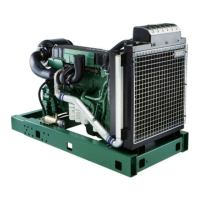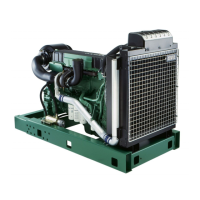Do you have a question about the Volvo Penta TAD1170VE and is the answer not in the manual?
Covers daily checks, PPE, eye/skin protection, fire safety, and handling chemicals.
Addresses safe engine starting, ventilation, rotating parts, and prohibiting start spray.
Safety measures for electrical, cooling, welding, and hot component work.
Precautions for refueling, fuel quality, leak detection, and pipe handling.
Hazards of batteries, electrolyte, correct polarity, and electrical connections.
Safety during engine cleaning, component cleanliness, and clutch adjustments.
Explains the manual's purpose, content, and warranty obligations for the owner.
Details on running in new engines and recommended fuels, oils, and coolants.
Importance of parts, servicing, and Volvo Penta's environmental considerations.
Requirements for emission-certified engines and the emission aftertreatment system.
Information on the dealer network and action service support.
Introduces the engine models and their key features like EMS and EATS.
Explains the Engine Management System (EMS) and Exhaust Aftertreatment System (EATS).
Covers AdBlue/DEF tank, level monitoring, heating, storage, and safe handling.
Details the CIM panel functions for control, monitoring, and diagnostics.
Explains display menus, status bar symbols, and alarm message types.
Covers display settings, language, units, and information retrieval.
Describes the DCU II panel functions for control, monitoring, and diagnostics.
Essential checks before starting the engine, including fluid levels and leaks.
Steps for starting the engine and preparations for extreme cold.
Procedures and safety for using auxiliary batteries for starting.
Guidelines for monitoring engine instruments and understanding alarms.
Explains hazards of prolonged low-load operation and mitigation steps.
Steps to take before stopping the engine and the shutdown process.
Actions to perform after the engine has been shut down.
Purpose of diagnostics, fault codes, and how malfunctions are reported.
Guide to identifying and resolving engine malfunctions based on symptoms.
Explains EATS system warnings, power reduction, and component defect checks.
Comprehensive list of fault codes (SPN, FMI) and their corresponding engine components.
Outlines recommended service intervals and content for engine maintenance.
Covers general engine checks, component orientation, and specific maintenance items.
Procedures for changing belts, filters, and checking fluid levels (oil, fuel, coolant).
Detailed steps for checking, topping up, draining, and cleaning the cooling system.
Covers filling, filter changes, and error handling for the AdBlue/DEF system.
Instructions for maintaining the electrical system, main switch, and batteries.
Guidelines for conserving the engine for storage and bringing it back into service.
Provides key technical data for the engine models, including bore, stroke, and displacement.
Details on oil capacity, pressure, recommendations, and fuel quality requirements.
Specifications for the cooling system and water quality standards for coolant.
Data on electrical system components, batteries, and engine identification.
Declaration related to machinery directive compliance.
| Engine Model | TAD1170VE |
|---|---|
| Manufacturer | Volvo Penta |
| Engine Type | Diesel, 4-stroke |
| Number of Cylinders | 6 |
| Aspiration | Turbocharged |
| Fuel System | Common rail injection |
| Cooling System | Liquid Cooled |
| Emissions Compliance | EU Stage V |











